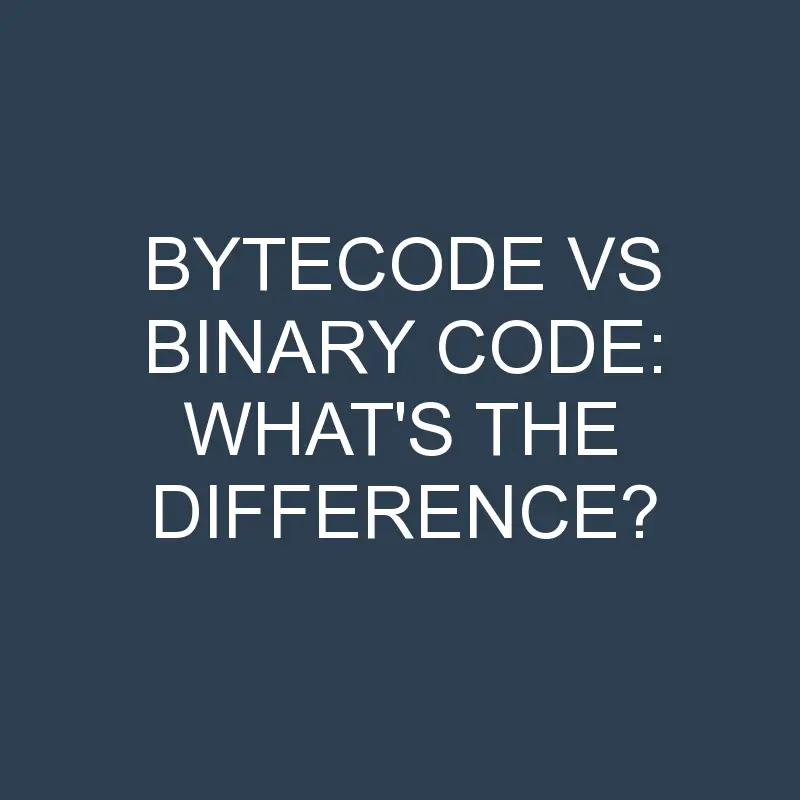Post Contents
Bytecode Vs Binary Code: What’s the Difference?
Most people have heard of binary code, but bytecode is a bit more obscure. Binary code is the code that computers understand, and it is made up of bits that are either 1 or 0. Bytecode is a type of binary code that is used to execute programs on a virtual machine or a processor. In this article, we will explore the difference between binary code and bytecode, and how each one is used.
What is Bytecode?
Bytecode is a form of instructions that can be read and executed by a computer. It is typically stored in a file with a .class extension. When a program is compiled, the compiler converts the source code into bytecode. The bytecode can then be run on any platform that has a Java Virtual Machine (JVM).
Bytecode is not specific to any one platform or architecture, which makes it portable. However, because it is not compiled directly into machine code, it generally runs more slowly than native code.
What is Binary Code?
Binary code is a system of encoding data using the binary number system. In this system, there are only two possible values for each digit: 0 and 1. This system is used because it is easy for computers to understand and process.
Binary code can be used to represent any type of data, including text, images, and audio. When you look at a piece of binary code, it may not look like anything meaningful. However, when a computer reads the code, it can translate it into the appropriate data.
The Difference Between Bytecode and Binary Code
When it comes to programming, there is a lot of terminology that can be confusing for beginners. Two terms that often come up are bytecode and binary code. So, what’s the difference between bytecode and binary code?
Bytecode is a type of code that is generated by a compiler. It is then interpreted or run by a virtual machine or runtime environment. Binary code, on the other hand, is a type of code that is directly executed by the processor.
Bytecode is usually platform-independent, meaning it can be run on any type of system. However, binary code is specific to the type of processor it was compiled for and cannot be run on other types of processors.
In general, bytecode runs slower than binary code because it needs to be interpreted by a virtual machine. However, bytecode can be optimized to run faster than binary code in some cases.
overall, the main difference between bytecode and binary code is that bytecode is interpreted while binary code is directly executed by the processor. Bytecode is usually platform-independent while binary code is specific to the type of processor it was compiled for.
How to Convert Binary Code to Bytecode
If you’re a software developer, then you’re probably familiar with binary code. But what is bytecode? And how is it different from binary code?
In a nutshell, bytecode is a type of compiled code that is typically used for platforms that use a virtual machine (VM) model. In other words, the code is executed by a VM instead of being directly executed by the computer’s hardware. Because bytecode is platform-independent, it can be used to run programs on any type of system, regardless of the underlying architecture.
One advantage of using bytecode is that it makes reverse engineering more difficult. That’s because the code is not easily human-readable like binary code or source code. However, it’s important to note that bytecode is not necessarily more secure than other types of code. It can still be decompiled back into readable code if someone has the right tools and know-how.
So, what’s the difference between binary code and bytecode? Binary code is directly executable by the computer’s hardware, while bytecode must be interpreted by a VM. Bytecode is also generally less readable than binary or source code, but this isn’t always the case. Ultimately, it’s
How to Convert Bytecode to Binary Code
Converting bytecode to binary code is a simple process that can be done using a number of different tools. The most common tool for this is a compiler, which can take your bytecode and convert it into an executable file.
There are a few things to keep in mind when converting bytecode to binary code. First, you need to make sure that your bytecode is in the correct format. Most compilers will only accept bytecode that has been compiled using the same compiler.
Second, you need to ensure that your bytecode is optimized for the target platform. This means making sure that it is in the correct endianness and alignment for the platform.
Finally, you need to make sure that your bytecode is signed with a valid signature. This signature needs to be generated using a private key that is associated with your development team. Without this signature, your code will not be able to run on the target platform.
Once you have these three things squared away, converting your bytecode to binary code is a relatively straightforward process. Simply run your code through the compiler of your choice and sign it with your development team’s private key.
Conclusion
In conclusion, bytecode and binary code are two very different things. Bytecode is a type of code that is interpreted by a virtual machine, while binary code is a type of code that is compiled to run on a physical machine. Each has its own advantages and disadvantages, so it’s important to choose the right one for your needs.
